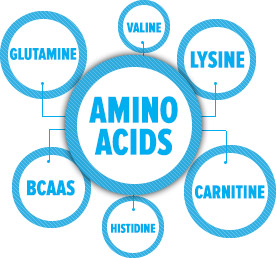Amino acid as a supplement have been used for many years & were very popular in the late 80s – early 90s then seemed to take a bit of back seat with the emergence of creatine & pre work out supplements, but have late began to more & more popular again.
I personally have started taking them again since the beginning of the year & do feel some benefit from doing so as I feel I recover faster from my workouts.
What are they?
Amino acids build proteins, and proteins are life-sustaining macronutrients. Yet simply calling amino acids the building blocks of protein doesn’t do justice to their value. While some amino acids only make proteins, others fill a variety of roles, from supporting metabolism to protecting your heart. Your body can also use them for energy when you lack carbs and fats.
Build protein
When cells need protein, they follow instructions from DNA that define the specific amino acids and the order in which they must connect to build the protein. DNA depends on another macromolecule — RNA — to make the protein. RNA takes a copy of the code from your DNA, leaves the cell, finds the amino acids and brings them back to the cell, where they bind into a chain. Each amino acid must be available at the time it’s needed or the protein won’t be synthesised. When the chain is complete, it twists and folds into a specialized shape. The chemical structure of each amino acid controls the final shape, and the shape determines the function of the protein.
Protect cardiovascular health
Your body uses the amino acid arginine to make nitric oxide. Nitric oxide helps lower blood pressure by relaxing muscles in your blood vessels. It’s produced in heart muscles, where it regulates contractions. It may also prevent atherosclerosis by inhibiting the development of plaque in your arteries.
Metabolism & other functions
Your body prefers to use carbs and fats for energy, but when necessary, amino acids are metabolized for energy. Three amino acids — glutamic acid, cysteine and glycine — combine to form glutathione, which is an antioxidant. The amino acid histidine makes enzymes used to produce red blood cells and maintain healthy nerves. Tyrosine is needed to synthesize thyroid hormones, while methionine makes SAMe, or S-adenosylmethionine. SAMe is essential for the metabolism of DNA and neurotransmitters.

